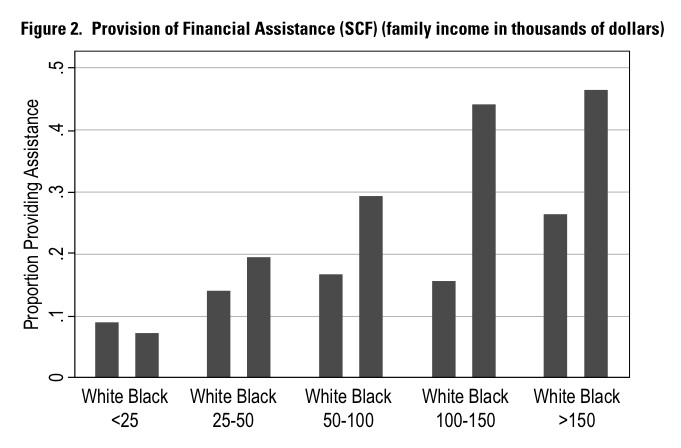Cross-posted at Policy Mic and The Huffington Post.
The gap between the household wealth of Black and White families is massive. Today the median wealth held by White households is 20 times that of Black households. There are lots of reasons for this difference and a new study offers great data on one of them: the need to assist poor relatives.
Kevin Hartnett, at Braniac, writes:
Middle-income blacks are more than twice as likely as middle-income whites to have a poor sibling and more than four times as likely to have parents below the poverty line. And because of these relationships, they’re called upon more often to provide financial assistance.
Sociology graduate student Rourke O’Brien used data on spending and other financial patterns among Americans to test whether this is a significant source of the wealth gap (link). He found that, at all but the most low income level, Black households are more likely than White households to give money to struggling relatives. And the wealthier the Black household, the more likely they were to help others.
The graph below illustrates this. The vertical axis represents the proportion of households offering assistance and the horizontal axis represents increasing income levels (in thousands of dollars).
The lesson is simple, but all too often unnoticed. Due to hundreds of years of enslavement and discrimination, African Americans are more likely to be poor than Whites. If you grow up poor then most of the people in your family are poor. Accordingly, even if you “make it out” and arrive in the middle class (income-wise), you will likely be less financially secure than a person that earns the same income but came from a middle class family. That person can put all of their extra money towards buying a home (and earning equity), retirement, additional degrees, starting a business, and sending their kids to college.
But the poor person who earns a middle-class income might use a significant portion of their income keeping their parents’ heat on, helping their little brother go to college, or buying back-to-school clothes for their nieces and nephews. This makes it much harder for poor and working class people who become middle class to stay that way. And the cycle continues.
Lisa Wade, PhD is an Associate Professor at Tulane University. She is the author of American Hookup, a book about college sexual culture; a textbook about gender; and a forthcoming introductory text: Terrible Magnificent Sociology. You can follow her on Twitter and Instagram.








